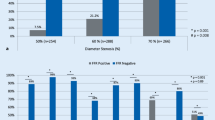Abstract
Balloon occlusion is a potential method for inducing hyperemia to measure post-percutaneous coronary intervention (PCI) fractional flow reserve (FFR). The objective of this study was to determine the clinical usefulness of post-occlusional hyperemia. FFRs measured using post-occlusional hyperemia caused by 30 (FFRoccl30) and 60 s (FFRoccl60) of balloon occlusion after PCI were compared in 60 lesions from 60 patients. The duration of hyperemia was also measured. There was a strong correlation between FFRoccl30 and FFRoccl60 (r = 0.969, p < 0.01). The duration of hyperemia was significantly longer with FFRoccl60 than with FFRoccl30 (68 ± 23 vs. 37 ± 15 s, p < 0.01). The time required for pullback curve analysis was around 45 s. However, in 7 (12%) cases, the duration of hyperemia with FFRoccl60 was < 45 s, which was not enough for pull-back curve analysis. To predict the duration of hyperemia with FFRoccl60 ≥ 45 s, the receiver operating characteristic curve analysis revealed a cut-off value of 25 s of hyperemia with FFRoccl30. FFRoccl30 is sufficient for diagnostic purposes. FFRoccl60 is suitable for pull-back curve analysis in select cases based on predictions made using the duration of hyperemia with FFRoccl30.





Similar content being viewed by others
References
Nam CW, Hur SH, Cho YK, Park HS, Yoon HJ, Kim H, et al. Relation of fractional flow reserve after drug-eluting stent implantation to one-year outcomes. Am J Cardiol. 2011;107:1763–7.
Pyxaras SA, Toth GG, Di Gioia G, Ughi GJ, Tu S, Rusinaru D, Adriaenssens T, et al. Anatomical and functional assessment of Tryton bifurcation stent before and after final kissing balloon dilatation: evaluations by three-dimensional coronary angiography, optical coherence tomography imaging and fractional flow reserve. Catheter Cardiovasc Interv. 2017;90:E1–E10.
Kobayashi Y, Nam CW, Tonino PA, Kimura T, De Bruyne B, Pijls NH, FAME Study Investigators, et al. The prognostic value of residual coronary stenoses after functionally complete revascularization. J Am Coll Cardiol. 2016;67:1701–11.
Kawase Y, Omori H, Kawasaki M, Tanigaki T, Hirata T, Okamoto S, et al. Postocclusional hyperaemia for fractional flow reserve after percutaneous coronary intervention. Circ Cardiovasc Interv. 2017;10:e005674.
Seto AH, Tehrani DM, Bharmal MI, Kern MJ. Variations of coronary hemodynamic responses to intravenous adenosine infusion: implications for fractional flow reserve measurements. Catheter Cardiovasc Interv. 2014;84:416–25.
Coffman JD, Gregg DE. Reactive hyperaemia characteristics of the myocardium. Am J Physiol. 1960;199:1143–9.
Marcus M, Wright C, Doty D, Eastham C, Laughlin D, Krumm P, et al. Measurements of coronary velocity and reactive hyperaemia in the coronary circulation of humans. Circ Res. 1981;49:877–91.
Eltzschig Holger K. Adenosine: an old drug newly discovered. Anesthesiology. 2009;111:904–15.
Jeremias A, Filardo SD, Whitbourn RJ, Kernoff RS, Yeung AC, Fitzgerald PJ, et al. Effects of intravenous and intracoronary adenosine 5-triphosphate as compared with adenosine on coronary flow and pressure dynamics. Circulation. 2000;101:318–23.
Probst P, Zangl W, Pachinger O. Relation of coronary arterial occlusion pressure during percutaneous transluminal coronary angioplasty to presence of collaterals. Am J Cardiol. 1985;55:1264–9.
Pijls NH, Bech GJ, El Gamal MI, Bonnier HJ, De Bruyne B, Van Gelder B, et al. Quantification of recruitable coronary collateral blood flow in conscious humans and its potential to predict future ischemic events. J Am Coll Cardiol. 1995;25:1522–8.
Agarwal SK, Kasula S, Hacioglu Y, Ahmed Z, Uretsky BF, Hakeem A. Utilizing post-intervention fractional flow reserve to optimize acute results and the relationship to long-term outcomes. J Am Coll Cardiol Intv. 2016;9:1022–31.
Choi KH, Lee JM, Koo BK, Nam CW, Shin ES, Doh JH, et al. Prognostic implication of functional incomplete revascularization and residual functional SYNTAX score in patients with coronary artery disease. J Am Coll Cardiol Intv. 2018;11:237–45.
Acknowledgements
We thank Shunsuke Imai for his work in collecting and analyzing all study-related data.
Funding
None.
Author information
Authors and Affiliations
Corresponding author
Ethics declarations
Conflict of interest
The authors have no conflicts of interest to declare.
Research involving human participants and/or animals
The study was approved by the local ethics committee and conformed to the human research concepts contained in the Declaration of Helsinki.
Informed consent
Written informed consent was obtained from each patient.
Additional information
Publisher's Note
Springer Nature remains neutral with regard to jurisdictional claims in published maps and institutional affiliations.
Electronic supplementary material
Below is the link to the electronic supplementary material.
Rights and permissions
About this article
Cite this article
Hirata, T., Tanigaki, T., Kawase, Y. et al. Post-occlusional hyperemia for fractional flow reserve assessment and pull-back curve analysis. Cardiovasc Interv and Ther 35, 142–149 (2020). https://doi.org/10.1007/s12928-019-00579-9
Received:
Accepted:
Published:
Issue Date:
DOI: https://doi.org/10.1007/s12928-019-00579-9




